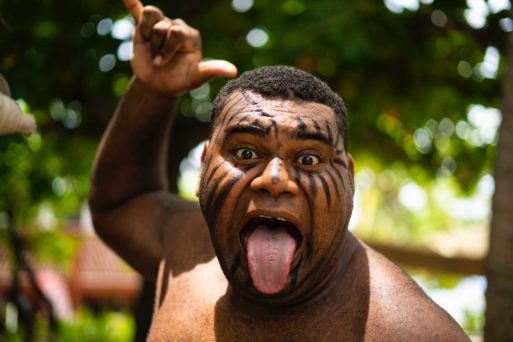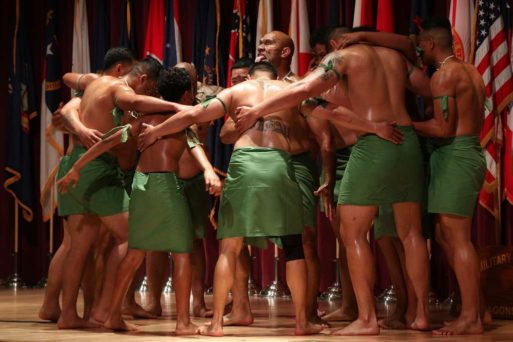 Polynesians traditionally paint their faces when performing haka rituals.
Polynesians traditionally paint their faces when performing haka rituals.Haka is a traditional custom for Maori, members of the indigenous Polynesian people of New Zealand. The practice has been regarded as a powerful means of expression for hundreds of years. Haka is an energetic dance that involves the entire body. Vigorous rhythmic movements include slapping of the chest and thighs and stamping of the feet. Loud chanting, fierce facial expressions and forceful gestures accompany those rigid maneuvers. Haka is a means of intense emotional declaration used to mark social occasion, including funerals. Maori convey their mourning through this ceremonious rite.
The custom has its origins in Maori legend. It is the dance of Tane-rore, the son of the sun God and his wife. The shimmering appearance of heated air in midsummer is referred to as “The Dancing of Tane-rore.” The waving heat is believed to represent the haka he once performed for his mother. The quivering hands and rapid movements of the dance pay homage to the legend of Tane-rore.
The most famous of this dramatic ritual begins with repeated shouts of “Ka mate! Ka mate! Ka ora! Ka ora!” This translates to “I die! I die! I live! I live!” The rest of this most-notable haka incarnation translates as follows: “This is the hairy man that brought the sun and made it shine again. One step up! Another step up! Another step up! The sun shines!”

A Samoan dance group performs a haka in traditional Polynesian garb
The custom is generally performed as a group. The belief is that haka instills strength into the participants. Once touted as a war dance, the ritual was used as a battle preparation; a heralded passionate display of the tribe’s solidarity. It is now most commonly used as a greeting for distinguished guests or presented as a social ritual at significant life events including weddings and funerals.
There are a variety of videos on YouTube that showcase this powerful grieving tribute. The body language and emotional expressions are a very moving display of united despair. The video below captures the intense grief of young men and women honoring the loss of their 17-year old friend. Another video of hundreds of students performing haka in honor of a deceased mentor garnered 13 million views.
Variation in phrasing, or chanting, is common. Its use has ceremoniously evolved in modern times, as well. New Zealand’s rugby team, “All Blacks,” has performed variations of haka before their matches to intimidate the opposing team since the early 20th century.
A haka performance by the “All Blacks” was featured in the Clint Eastwood film, “Invictus,” in 2009. This scene brought international recognition to its cultural significance. The team’s performance on the field prior to a 2019 World Cup series game against England went viral. Although they ultimately lost that game, the performance was the most watched video in the World Cup series that year.
The global impact of the New Zealand’s rugby team haka performances has spurred debate about its cultural appropriation. The power required to express such passion and vigor is tied to the identity of their Polynesian ancestors. Participating members of the team are all native to New Zealand. It is believed that haka should not be performed by other cultures or societies as a means of respect to its Maori heritage.

 Haka Helps Polynesians Express Grief
Haka Helps Polynesians Express Grief


 Debating Medical Aid in Dying
Debating Medical Aid in Dying
 “Help Me, Helen”
“Help Me, Helen”















